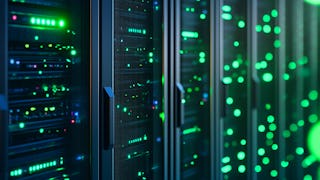Keen to kickstart your IT career with networking and storage skills employers need? This beginner course introduces essential IT concepts to help you diagnose and support modern systems.

Enjoy unlimited growth with a year of Coursera Plus for $199 (regularly $399). Save now.

Introduction to Networking and Storage
This course is part of multiple programs.

Instructor: IBM Skills Network Team
39,559 already enrolled
Included with
(566 reviews)
Recommended experience
What you'll learn
Explain wired and wireless network types, topologies, cable categories, IP addressing, packet flow, and core protocols
Configure secure networks and mobile devices using encryption standards and troubleshooting tools, including the command prompt and Windows Settings
Explore memory and storage technologies, including RAM, ROM, RAID, STaaS, file/block/object storage, USB4, and NVMe, andtroubleshooting methods
Apply NFC operating modes, Wi-Fi security protocols, and device integration techniques to evaluate modern networking and storage solutions
Skills you'll gain
- TCP/IP
- Data Storage
- Command-Line Interface
- Microsoft Windows
- Network Security
- Networking Hardware
- Wide Area Networks
- Wireless Networks
- OSI Models
- Network Architecture
- Data Storage Technologies
- Network Protocols
- Local Area Networks
- Computer Networking
- Hardware Architecture
- Network Infrastructure
- Network Troubleshooting
- System Configuration
- General Networking
Details to know

Add to your LinkedIn profile
See how employees at top companies are mastering in-demand skills

Build your subject-matter expertise
- Learn new concepts from industry experts
- Gain a foundational understanding of a subject or tool
- Develop job-relevant skills with hands-on projects
- Earn a shareable career certificate

There are 5 modules in this course
Computer networking plays a vital role in facilitating the communication required in almost every aspect of daily life. Activities like talking with friends and family, collaborating with coworkers, paying bills, and even completing transactions at a store often depend on some form of computer networking. Computer networking is defined as the connection of people through the use of devices and cables, and sometimes wireless signals. This week, you will learn about the basic types and shapes of networks and how they are used. You will explore wireless networking fundamentals including SSID configuration, access point deployment, and security protocols ranging from WPA evolution to WPA3 implementation. The module examines 802.11ax (Wi-Fi 6) standard features, frequency band characteristics, and channel planning strategies. And finally, you will learn about the advantages and disadvantages of each network type.
What's included
7 videos2 readings2 assignments3 plugins
Understanding the foundations of how all networks behave is achieved by investigating the rules. That includes finding out how each rule works and observing how each rule is applied to the network and how the network is affected by that rule. This week, you will learn about networking devices and the basic instructions they follow to connect us in the ways we expect. You will understand how data is packaged electronically, which rules are used to send the data, how those rules are made, and how computers determine where to send those data packages. You will also gain insights on the near field communication (NFC) principles.
What's included
6 videos1 reading2 assignments3 app items2 plugins
One of the key components of communicating is understanding how to communicate. That includes knowing what enables communication, and what blocks it. This is just as true for computer networking as it is for person-to-person interactions. If you don’t understand the ways to get data from one point to another, the data will never arrive where you want it to. This week you will learn the basic steps for setting up small office or home office networks—including wired, wireless, and mobile configurations. You’ll explore Network Settings in Windows and then learn what causes network connectivity problems and how to resolve those problems. Finally, you will learn how command line utilities can be used to find network information and diagnose network issues.
What's included
6 videos1 reading2 assignments3 app items2 plugins
As we’ve discussed, connection plays a vital role in communication. Another key component in communication is memory; information is not useful if it can’t be recalled. Network storage is where the memory is located in computer networking. This week you will learn about different types of network storage and basic storage troubleshooting. You’ll learn about short-term and long-term memory, and the different ways that memory can be arranged to increase capacity and efficiency. Additionally, students will investigate high-performance NVMe storage technologies, understanding PCIe integration and performance optimization factors. You’ll also learn about local, offsite, and cloud memory and how all these different kinds of memory enable faster and more efficient interaction between people, devices, and software.
What's included
6 videos1 reading2 assignments1 app item3 plugins
In this module, you’ll assess your course knowledge through a final project and a final quiz based on the previous modules.
What's included
2 videos2 readings1 assignment1 discussion prompt4 plugins
Earn a career certificate
Add this credential to your LinkedIn profile, resume, or CV. Share it on social media and in your performance review.
Instructor

Offered by
Explore more from Networking
 Status: Preview
Status: Preview Status: Free Trial
Status: Free Trial Status: Free Trial
Status: Free Trial
Why people choose Coursera for their career




Learner reviews
566 reviews
- 5 stars
81.44%
- 4 stars
13.95%
- 3 stars
3.18%
- 2 stars
0.70%
- 1 star
0.70%
Showing 3 of 566
Reviewed on Aug 7, 2022
Great course and I have learn about many new and old technologies.
Reviewed on Jun 2, 2023
I get a lot of essentials knowledge about the networking technique. A lot of thanks to my instructor (Coursera and IBM).
Reviewed on Oct 4, 2023
This course help me to understand the basics of networking. Got a lot to learn
Frequently asked questions
This course is completely online. There’s no need to show up to a classroom. You can access your lectures, readings, and assignments anytime and anywhere on the web or your mobile device.
The fields of networking and storage combine hardware and software so people can connect, share, save time, boost privacy, and conduct business more efficiently.
There are many career opportunities in the field of Networking and Storage. For example, IT support roles, network technician roles, system administration roles, and technical program manager roles.
More questions
Financial aid available,
¹ Some assignments in this course are AI-graded. For these assignments, your data will be used in accordance with Coursera's Privacy Notice.






